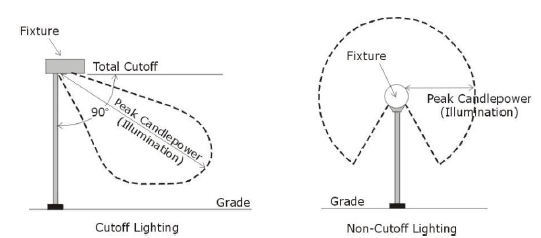(a) Purpose. The purpose of this section is to regulate outdoor lighting elements as they contribute to the identity of a development or project. It is also the purposes of these regulations to ensure the safety of pedestrians while minimizing light pollution and the negative impacts of excessive glare.
(b) Applicability.
(1) The standards of this section shall apply to the following development activities:
A. Construction of all new buildings in nonresidential zoning districts;
B. Construction of all new nonresidential buildings in residential zoning districts;
C. Establishment or expansion of any vehicular use areas; or
D. Addition of outdoor lighting fixtures regulated by this section
(2) The requirements of this section shall not apply for a lighting related to single-family, two-family, and three-family dwellings, however, all lighting for these uses, with the exception of low-voltage landscaping lighting, shall be completely shielded from adjacent properties.
(3) The applicant must provide a plan that identifies the location, height, and type of luminaries, and shows how the applicant intends to comply with this section.
(c) Lighting standards.
(1) General standards.
A. The placement of light poles within raised curb planting areas or landscaped islands should be the priority location, but conflicts with parking lot trees that can obscure the lighting shall be avoided through alternative lighting locations.
B. Outdoor lighting shall not be designed or located in such a way as to shine directly into an adjacent dwelling unit, regardless of the applicable zoning district.
C. All outdoor lighting for nonresidential uses shall be located, screened, or shielded so that adjacent lots or streets located in residential districts are not directly illuminated.
(2) Building-mounted lighting.
A. Lighting may be mounted to a building façade only at entrances, loading/service locations, or for the purpose of accent lighting.
B. In no case shall a light fixture mounted on a structure be mounted at a height where the fixture will exceed the height of the roofline.
(3) Ground-mounted lighting. The maximum height of a light fixture, if mounted on a pole or on a structure other than the principal building, is 25 feet.
(4) Lighting intensity and glare.
A. Lighting must be selected, located, aimed and shielded, using cutoff shields or similar measures, so as to focus illumination exclusively on the intended site elements and away from adjoining properties and public streets.

B. Table 1208-1 includes lighting level guidelines for individual site elements.
Lighting Location or Illuminated Site Element | Lighting Standard | Maximum to Minimum Lighting Ratio |
Internal Driveways and Roads (Non-Public) | Average of 1.5 foot-candles | Four to One |
Drop-Off Areas | Minimum of 2.0 foot-candles | Four to One |
Other Vehicular Use Areas | Average of 0.8 foot-candles | Four to One |
Pedestrian Traffic Areas | Average of 1.25 foot-candles | Four to One |
Building Entrances | Minimum of 2.0 foot-candles | Three to One |
(Ord. O2018-02, passed 2-20-2018)